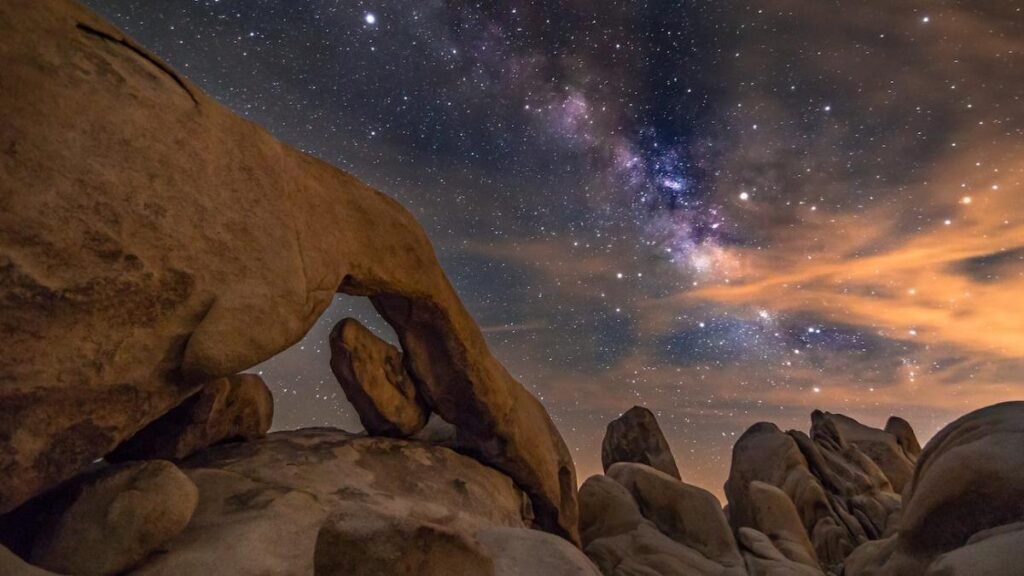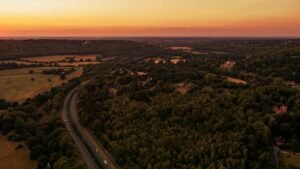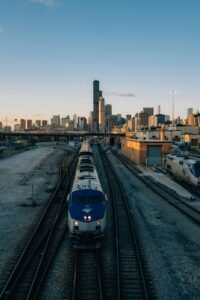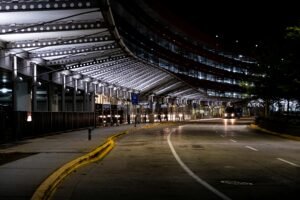There’s something otherworldly about Joshua Tree. Where else can you see alien-like Joshua trees stretch their limbs toward the sky, stroll through landscapes dotted with vibrant desert wildflowers, and—when night falls—witness the cosmos unfold in complete silence?
This is where Desert Flora and Stargazing in Joshua Tree become more than just a sightseeing checklist—they turn into a soul-stirring experience.
In this ultimate 2025 travel guide, we go beyond the basics to help you discover the best time for stargazing in the California desert, where to find peak blooms, the top trails for nighttime desert hikes in Joshua Tree, and how to capture Milky Way Joshua Tree photography that belongs on a gallery wall.
Table of Contents
When to Visit for Peak Blooms
At first glance, the desert might seem dry and lifeless. But come spring—especially between March and April—Desert Flora and Stargazing in Joshua Tree becomes more than just a dream. The entire landscape transforms into a painter’s palette of wild color, offering one of the most photogenic desert experiences in the U.S.
Depending on seasonal rainfall, you may be lucky enough to witness:
- Desert Dandelions carpeting the earth in golden hues
- Sand Verbena trailing lavender blooms across rocky ground
- Cholla Cactus shimmering in the sun, like desert chandeliers
- Beavertail Cactus flaunting hot pink blossoms against a dusty backdrop
- And of course, the famous Joshua Tree, rising like a twisted sculpture under the open sky
If you’re planning a visit during or after a particularly rainy winter, you may even catch a super bloom—a rare and breathtaking event where thousands of wildflowers bloom simultaneously. It’s like stepping into a desert fairytale, perfect for Milky Way Joshua Tree photography or capturing that magical golden hour light.
Pair your wildflower walk with nighttime desert hikes in Joshua Tree, and you’ll experience both the fragile beauty of daytime blossoms and the awe-inspiring vastness of the night sky.
This seasonal phenomenon makes spring not only the best time for desert flora but also the best time for stargazing in the California desert—where crystal-clear skies and low humidity set the perfect stage for spotting planets, constellations, and the glowing arms of the Milky Way.
Why Joshua Tree is a Stargazing Paradise
There’s a reason why Desert Flora and Stargazing in Joshua Tree has become a bucket list experience for travelers and nature lovers alike. As one of the top-ranked Dark Sky Parks in the United States, Joshua Tree offers something few places can: the ability to see deep into the cosmos with minimal light pollution and crystal-clear visibility.
For those wondering about the best time for stargazing in the California desert, plan your trip between late fall and early spring. The skies are clearer, temperatures are cooler, and the night views are simply unforgettable.
Here’s what you can expect when you look up at night in Joshua Tree:
- The Milky Way stretching from horizon to horizon, glowing with millions of stars—perfect for any Milky Way Joshua Tree photography enthusiast.
- Bright planets like Jupiter, Saturn, and Venus often visible with the naked eye.
- Dazzling meteor showers such as the Perseids in August or the Geminids in December, lighting up the desert sky in a way that feels almost surreal.
And it’s not just about standing still and watching the stars. Many visitors enjoy nighttime desert hikes in Joshua Tree, combining scenic moonlit trails with the serenity of a sky full of stars. It’s quiet, peaceful, and feels like you’re walking through a live planetarium.
Whether you’re setting up your tripod for a long exposure shot or lying back on a blanket with a warm drink, stargazing here feels like a spiritual experience. It’s not just about what you see—it’s about what you feel.
Top Stargazing Spots in Joshua Tree
When it comes to Desert Flora and Stargazing in Joshua Tree, few places offer such an enchanting blend of cosmic beauty and rugged desert terrain. Whether you’re chasing the Milky Way for photography, enjoying nighttime desert hikes in Joshua Tree, or simply hoping to catch a glimpse of a shooting star, these stargazing spots are your best bet.
1. Cap Rock
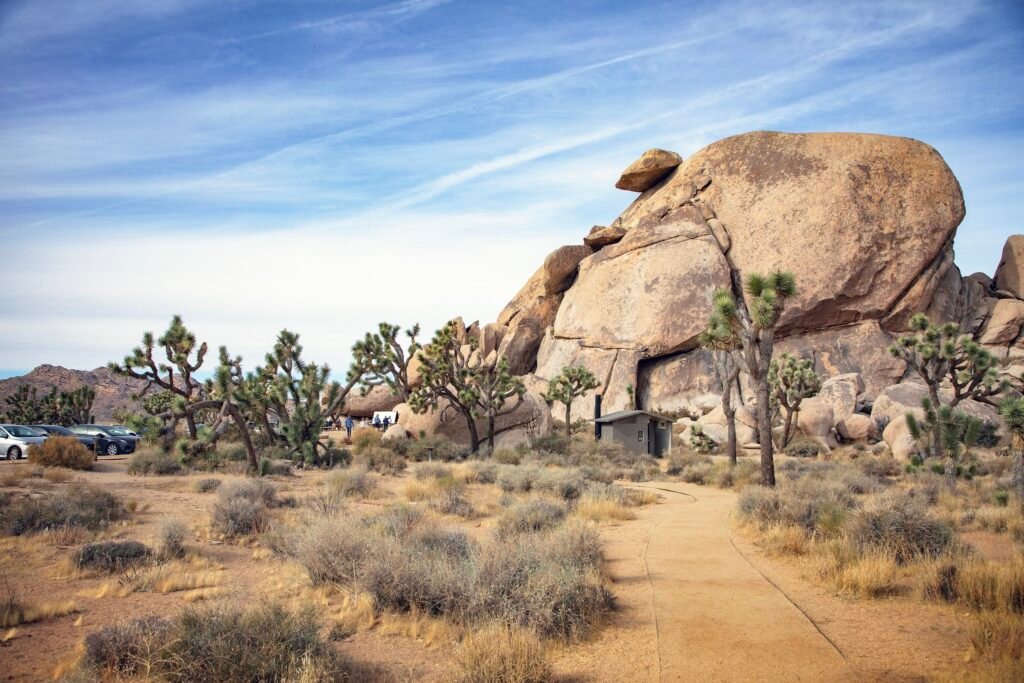
One of the easiest spots to access right off Park Boulevard, Cap Rock offers wide open skies and a fantastic foreground of weathered boulders and Joshua trees. It’s an ideal location for setting up your tripod and capturing Milky Way Joshua Tree photography at its finest.
📍 Learn more from the official NPS Cap Rock page
2. Keys View
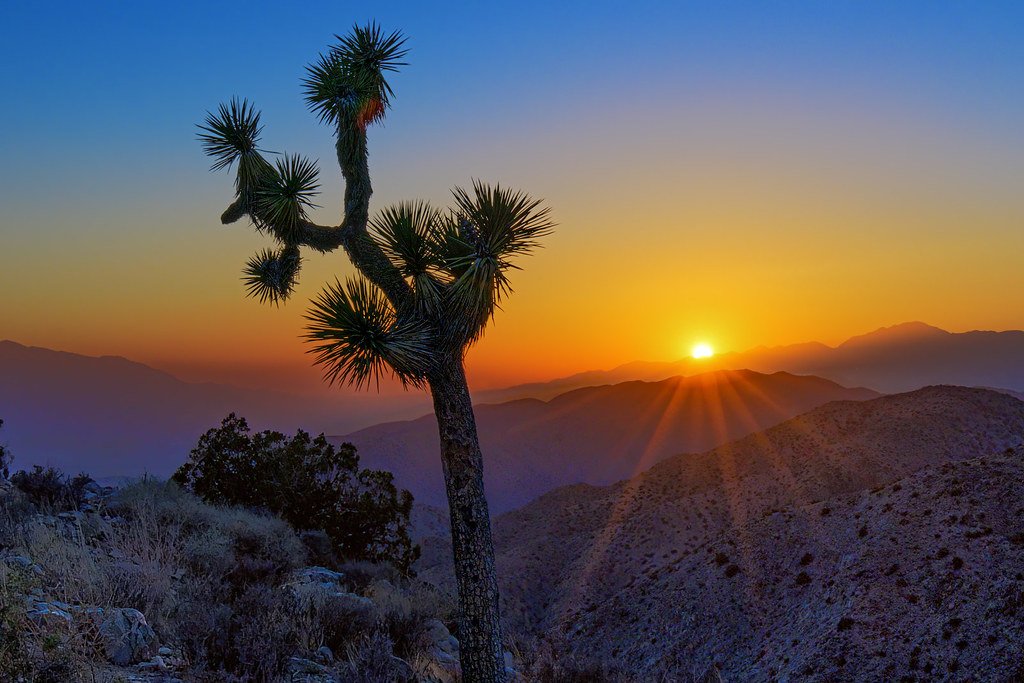
Want a view that feels like the edge of the world? Head up to Keys View, an elevated overlook offering panoramic views of the Coachella Valley, the San Andreas Fault, and beyond. The higher elevation gives you clearer air and a better chance of spotting planets on a cloudless night.
🌠 It’s also one of the best places for stargazing in the California desert, thanks to its broad, unobstructed horizon.
📍 View Keys View map and conditions
3. Cottonwood Campground
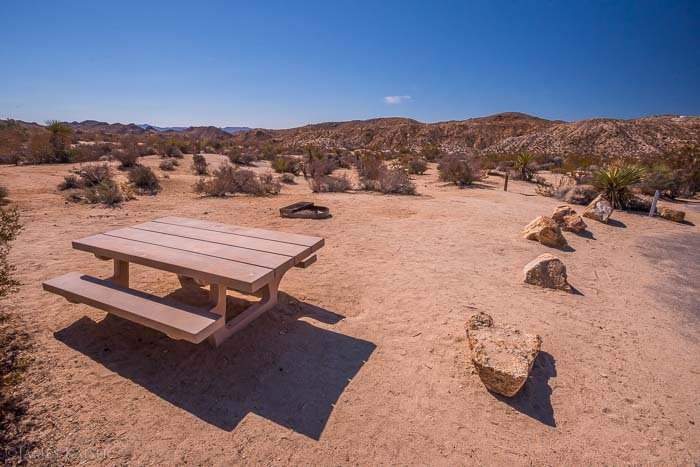
Located in the southeastern part of the park, Cottonwood is often overlooked by tourists, which means less light pollution and more solitude. It’s a peaceful, uncrowded place to set up for a long night of sky watching.
🌌 You’ll especially love this spot during meteor showers like the Perseids in August or the Geminids in December.
📍 Check Cottonwood Campground availability
4. Hidden Valley
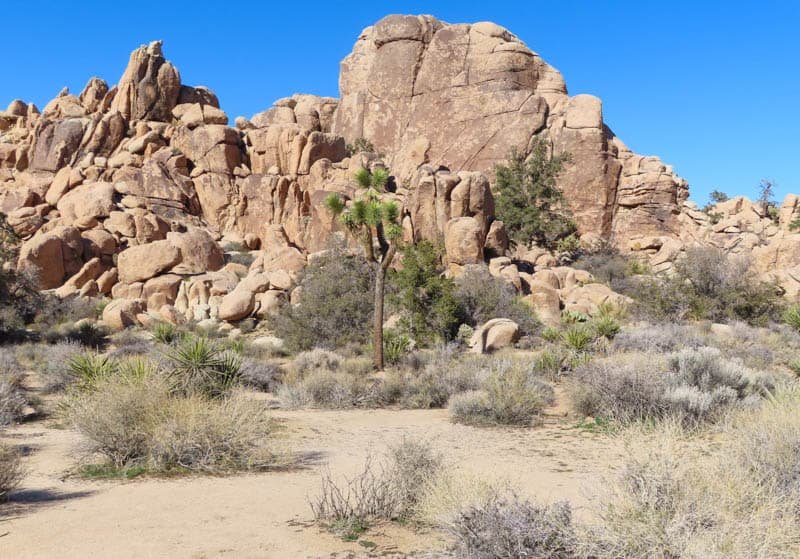
This area blends rock formations and desert flora, creating a dramatic and textured foreground that photographers adore. As one of the park’s most scenic spots for daytime hikes, it turns into a surreal dreamscape once the sun sets. Ideal for nighttime desert hikes in Joshua Tree, but always bring a red flashlight and stay on marked trails.
📍 Explore Hidden Valley trail details
5. Skull Rock
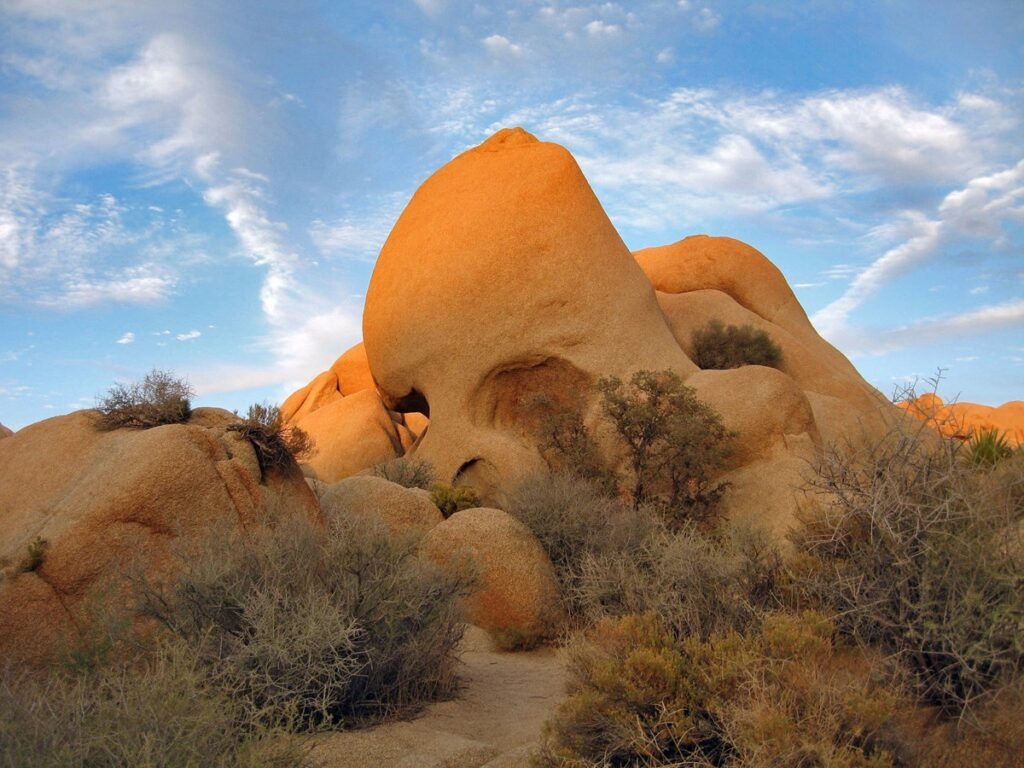
Famous for its eerie rock shaped like a human skull, this area feels especially magical (and a bit mysterious) under the moonlight. Skull Rock is right off the main road, so it’s easy to visit at night without too much planning. The mix of quirky rock features and starlit skies makes it perfect for a unique Joshua Tree night photography session.
Combine Both: Desert Flora and Stargazing in Joshua Tree Day-to-Night Itinerary
Looking to experience the best time for stargazing in California desert while also soaking in the beauty of blooming desert plants? This carefully curated Desert Flora and Stargazing in Joshua Tree itinerary blends both worlds—sunlit trails and star-lit skies.
Morning: Wildflower Hikes Among Iconic Joshua Trees
Start your day early with a hike through Hidden Valley or Barker Dam Trail. These trails are especially scenic during the spring bloom when desert wildflowers are in full glory. Expect a vivid display of desert marigold, purple verbena, and golden poppies. It’s a peaceful way to see native flora up close before the heat sets in.
Afternoon: Golden Hour at the Cholla Cactus Garden
As the sun begins its descent, head to the Cholla Cactus Garden. This spot is pure magic during golden hour. The sunlight catches the spines of the “teddy bear” cholla cactus, creating a glowing effect that’s a favorite for nature photographers. It’s a dream for anyone passionate about Milky Way Joshua Tree photography and capturing unique desert light.
Evening: Stargazing Setup at Cap Rock
Right before dusk, make your way to Cap Rock, one of the top spots for nighttime desert hikes in Joshua Tree and stargazing. Lay out a blanket, bring your favorite snacks, and set up your telescope if you have one. Even without gear, the experience is breathtaking.
This is when the sky slowly transforms—planets emerge, stars begin to twinkle, and the first glimmers of the Milky Way stretch across the horizon.
Night: Watch the Stars Come Alive
As darkness settles, you’ll understand why this park is a certified Dark Sky destination. This is truly the best time for stargazing in California desert. The night comes alive with constellations, shooting stars, and sometimes even the International Space Station passing overhead.
Be sure to pack a red-light headlamp to protect your night vision and a warm jacket—desert temperatures drop quickly after sundown.
This seamless blend of Desert Flora and Stargazing in Joshua Tree is one of the most magical ways to experience California’s high desert. From flower-filled trails to cosmic wonder, it’s a memory that will stay with you long after your footprints fade.
Photography Tips for Desert Flora and Stargazing in Joshua Tree
Capturing the beauty of Desert Flora and Stargazing in Joshua Tree isn’t just about having a camera—it’s about understanding the light, timing, and techniques that make this desert landscape come alive.
1. Focus on the Details with a Macro Lens
Joshua Tree’s wildflowers and cacti are full of surprising texture and color. A macro lens will help you highlight every tiny spine, bloom, or drop of morning dew. This technique works wonders when you’re exploring during the spring bloom season.
2. Get Ready for Milky Way Joshua Tree Photography
The park is one of the best locations in the world for Milky Way photography. Use a sturdy tripod and a wide-angle lens with long exposure (between 10 to 25 seconds). This will help you capture the stunning movement of the stars without motion blur.
3. Use a Remote Shutter for Stability
Even the tiniest shake can ruin a great astrophotography shot. To avoid this, bring a remote shutter or use a camera timer to reduce the chance of blur, especially during long exposures in low-light conditions.
4. Know the Best Time for Stargazing in the California Desert
Timing is everything. The best time for stargazing in California desert regions like Joshua Tree is during the new moon phase, preferably 1 to 2 hours after sunset when the sky is dark and clear. Spring and fall tend to have the clearest skies and mild temperatures, making them perfect for long photography sessions.
5. Plan for Nighttime Desert Hikes in Joshua Tree
Some of the most dramatic compositions come from nighttime desert hikes in Joshua Tree. Trails like Hidden Valley and Barker Dam offer incredible foregrounds to pair with the night sky. Bring a headlamp with a red-light setting to preserve your night vision and avoid disrupting other stargazers or wildlife
Getting There and What to Bring for Desert Flora and Stargazing in Joshua Tree
Planning a trip to experience the surreal Desert Flora and Stargazing in Joshua Tree? Here’s everything you need to know before you go.
Closest Airports
If you’re flying in, the most convenient airport is Palm Springs International Airport (PSP)—just about an hour’s drive from Joshua Tree. For those coming from further out or looking for more flight options, Los Angeles International Airport (LAX) is also a viable choice, around 2.5 to 3 hours away by car.
What to Pack
Exploring the best time for stargazing in California desert or catching desert blooms at their peak requires a little preparation. Whether you’re coming for the spring wildflowers or hoping to capture Milky Way Joshua Tree photography, here’s what you should bring:
- Plenty of water – the desert is dry year-round, and dehydration sneaks up fast
- High-energy snacks – perfect for hikes and stargazing sessions
- Sun protection – sunscreen, a hat, and sunglasses are non-negotiable during the day
- Layered clothing – while daytime can be warm, desert nights get chilly quickly
- A red-light flashlight or headlamp – ideal for nighttime desert hikes in Joshua Tree without disturbing the wildlife or your night vision
- Tripod and wide-angle camera lens – especially useful for Milky Way shots
- Sturdy hiking shoes – many of the trails have rocky or sandy terrain
Park Pass
Access to Joshua Tree National Park requires a $30 vehicle pass, which is good for seven consecutive days. If you plan to visit more national parks, consider the America the Beautiful Pass—just $80 for unlimited access to all U.S. national parks for a full year. It’s a solid investment for adventurers chasing desert blooms and stargazing nights.
Fun Local Tip for Stargazing Enthusiasts
If you’re planning your trip around Desert Flora and Stargazing in Joshua Tree, don’t miss the Sky’s The Limit Observatory & Nature Center located just outside the park in Twentynine Palms. This lesser-known gem offers telescope nights and live astronomy presentations that make stargazing both educational and magical.
It’s especially popular with families, first-timers, and those curious about the best time for stargazing in the California desert. On clear nights, visitors often capture stunning images for Milky Way Joshua Tree photography, and many even join guided nighttime desert hikes before the event begins.
Whether you’re an amateur astronomer or just want to understand what you’re seeing above you, this experience adds depth to your desert adventure. Bring a blanket, a red-light flashlight, and prepare to be wowed.
Visiting the observatory is a great way to elevate your journey and dive deeper into what makes Joshua Tree one of the most awe-inspiring places for nature and night sky lovers alike.
Final Thoughts
Desert Flora and Stargazing in Joshua Tree offer a rare and unforgettable fusion of daytime beauty and nighttime wonder. Imagine starting your day surrounded by vibrant desert wildflowers, then ending it beneath a sky filled with stars and the awe-inspiring sweep of the Milky Way.
If you’re wondering about the best time for stargazing in the California desert, spring and fall typically offer the clearest skies and mild temperatures—perfect for an evening out under the stars. Whether you’re into Milky Way Joshua Tree photography or simply soaking in the quiet on one of the nighttime desert hikes in Joshua Tree, the experience is deeply moving.
Joshua Tree isn’t just a destination—it’s a place to reconnect with nature, breathe deeply, and feel completely present. In 2025, give yourself the gift of stillness, stars, and blooming beauty.
This is your year to experience it all.
When is the best time to see wildflowers in Joshua Tree?
The peak season for desert wildflowers in Joshua Tree is typically from late February through April, depending on rainfall. Springtime offers the best chance to see colorful blooms like desert lilies, sand verbena, and cactus flowers.
Can you see the Milky Way in Joshua Tree?
Absolutely. Joshua Tree is a designated Dark Sky Park, making it one of the best places in California to view the Milky Way. The clearest views usually happen from March to October, especially during a new moon with no cloud cover.
What are the top spots for stargazing in Joshua Tree?
Popular stargazing spots include Cap Rock, Keys View, Cottonwood Campground, and Skull Rock. These areas offer wide-open skies with minimal light pollution, perfect for Milky Way Joshua Tree photography and meteor showers.
Is nighttime hiking allowed in Joshua Tree National Park?
Yes, nighttime desert hikes in Joshua Tree are allowed, and many trails are open 24/7. Just be cautious—bring flashlights (preferably red lights), stay on marked paths, and avoid hiking alone.
What gear should I bring for desert flora walks and stargazing?
Essentials include: sturdy hiking shoes, sunscreen, water, a wide-angle lens for night photography, a tripod, and layered clothing (desert nights get cold). Don’t forget binoculars or a telescope for enhanced stargazing.
Related Adventures You’ll Love
Looking to expand your journey beyond just Desert Flora and Stargazing in Joshua Tree? These guides offer equally unforgettable adventures tailored to your wanderlust—and they all complement your nature-focused getaway beautifully.
🔹 Travel to Your Roots, Responsibly: A Cultural Guide
Reconnect with heritage-rich destinations while being mindful of the environment. If you love nighttime desert hikes in Joshua Tree, this guide helps you slow down and travel with purpose across similar soul-stirring landscapes.
🔹 Luxury Rail Experiences for Retirees Across America
Prefer scenic comfort over sandy boots? This guide is perfect for travelers who’ve enjoyed Milky Way Joshua Tree photography and are now seeking elegant, stargazing-friendly train journeys through some of the nation’s quietest skies.
🔹 Senior-Friendly Cultural Itineraries for 2025
Designed for slow travel lovers and cultural explorers. If you’re curious about the best time for stargazing in California desert regions, these curated itineraries blend local experiences with gentle pacing—ideal after a serene escape to Joshua Tree.
